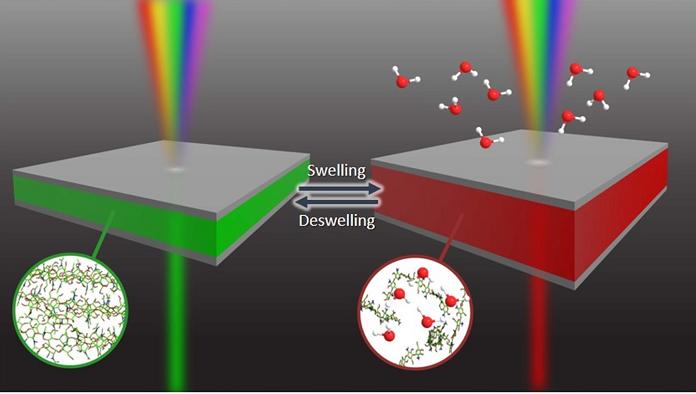Image credit: Osman Rana
Smart windows, also called switchable windows or smart glass, change color based on the intensity of sunlight through a phenomenon called electrochromism, in which materials change color (or switch from transparent to opaque) when you apply an electrical voltage across them. This technology is gaining attention as they can reduce energy bills by minimizing the intensity of the sun’s visible rays during summer, and use that incoming energy to generate power. But what about windows that change colors depending on the humidity outside, for example during the monsoon season or on the muggy-hot days of summer?
To this end, researchers have recently developed the source technology for smart windows that change colors according to changes in moisture, without needing electricity.
Sensors using light are already widely used, from measuring heart rates in an ECG, to air quality or distance. The basic principle is based on using light to detect changes in the surroundings by converting its wavelength into digital signals, which can be accomplished using structures called resonators.

Many sensors take advantage of “Fabri-Pero interference”, in which multiple beams of reflected light interfere with one another when light is shone through a cavity bounded by two parallel surfaces — achieve using thin films. It is known that the resonance wavelength of transmitted light can be controlled according to the thickness and refractive index of the dielectric layer. However, existing materials have a big disadvantage in not being able to control the wavelengths of transmitted light, making it difficult to use them in variable sensors.
To overcome this challenge, the research team successfully developed a variable color filter using a metal-hydrogel-metal resonator using a chitosan polymer-based hydrogel, and combined it with solar cells to make a self-powering humidity sensor. These findings were recenrlt published in the journal Advanced Optical Materials.
The research team found that when the chitosan hydrogel was made into the metal-hydrogel-metal thin film structure, the resonance wavelength of light transmitted changes in real time depending on the humidity of the environment. This is because the chitosan hydrogel repeatedly expands and contracts as the humidity changes around it.
Using this mechanism, the team developed a humidity sensor that can convert light’s energy into electricity by combining a solar battery with a water variable wavelength filter made of metal-hydrogel-metal structured metamterial that changes resonance wavelength depending on the external humidity.
The design principle is to overlap the filter’s resonance wavelength with the wavelength where the absorption of the solar cells changes rapidly. This filter is designed to change the amount of light absorption of solar cells depending on the amount of moisture, and to lead to electric changes that ultimately detect the surrounding humidity.
Unlike the conventional optical humidity sensors, these newly developed ones work regardless of the type of light, whether it be natural, LED, or indoor. In addition, not only do the sensors function without external power, they can also predict humidity based on the filter’s color.
Professor Junsuk Rho who led the research commented, “This technology is a sensing technology that can be used in places like nuclear power reactors where people and electricity cannot reach.” He added, “It will create even greater synergy if combined with IoT technology such as humidity sensors that activate or smart windows that change colors according to the level of external humidity.”
Reference: J. Jang, et al. ‘Self‐Powered Humidity Sensor Using Chitosan‐Based Plasmonic Metal–Hydrogel–Metal Filters.’ Advanced Optical Materials (2020). DOI: 10.1002/adom.201901932

















